Product catalogs are making a huge comeback.
No matter if you look at fashion retailers, cruise lines or even e-commerce platforms such as Amazon, more and more companies are publishing not only digital catalogs but also physical product catalogs to promote their goods.
But creating and maintaining fully-fledged product catalogs is an art of its own.
In this article, we are going to introduce you to 20 of the best catalog software you should use in 2024 to make the most of your catalog management process.
Supercharge your content reviews
Share, review, and approve all your content in one place with Filestage.
What is product catalog management?
Product catalog management is the process of creating and maintaining your physical or digital e-commerce product catalog. Before we introduce you to the best catalog management software solutions in 2024, we will cover all of the basics of product catalog management.
This type of digital asset management is a subcategory of marketing project management that ensures that all your customers, whether B2B or B2C, have access to your latest product data and visuals in order to boost revenue across all targeted sales channels.
Furthermore, this isn’t a one-off project, but an ongoing task.
The most important tasks of product feed management can be summarized as follows:
- Planning: Determine which products will be added to your catalog.
- Creation: Create new product entries and add discounts, trials or other events.
- Maintenance: Update current product data if necessary.
- Review and approval: Make sure your team and superiors agree with the content.
- Distribution: Distribute your physical or online product catalogs on a regular basis.
Depending on how many products you offer, the markets you serve, the scale of your business and how many details you want to include, catalog management can become a heavyweight task, one that requires a lot of resources and cross-functional collaboration.
Since the marketing and design functions of most companies are notoriously overworked and need to keep up with tight deadlines on an almost daily basis, you should use product management software to streamline and automate processes as much as possible, no matter if you need to create online product catalogs or physical.
In the following section, we list the benefits you can gain by using capable catalog management platform.
What is catalog software and why should you use it?
No matter what kind of marketing resource management tool you use, catalog management software can help you streamline your workflows through catalog design templates and automation features that reduce the time you spend on your projects.
Catalog management is more complex than you might think
Catalog content management is much more complicated than people would expect at first sight. You need to have a good overview of all upcoming products, plan which of these will be included in your catalog and make sure all other product information is up-to-date.
This involves collaboration across multiple departments. While marketing managers are usually responsible for the planning and distribution phase, the actual creation process is performed by the design department as well as internal or external copywriters.
Catalog management software contributes to the bottom line
Good product catalog software solution not only helps you shorten the implementation phase, but it also helps you plan, maintain and distribute your catalog with minimal effort.
Additionally, if you use physical catalogs, errors will result in huge costs, as there is no way you can distribute a finished catalog with incorrect pricing or product information. Therefore, good online product catalog software helps you increase consistency and mitigate failure rates.
As product catalog software enables you to create catalogs with stunning visuals and convincing product descriptions, it directly contributes to the bottom line of your business.
Are you convinced? Since you now have a good overview of what product catalog management entails and why you should make use of product management software, let’s take a closer look at 20 of the most commonly used catalog software solutions.
Overview of 20 catalog software tools
What is the best software to make a catalog? In the following section, we evaluate the Top 20 catalog management software you should try out in 2024.
1. Filestage – more than just catalog management

Filestage is an online proofing software that helps marketing and creative teams streamline the content review and approval process of catalogs, brochures and any other digital assets. The cloud-based platform offers annotation tools that allow users to leave clear and precise feedback directly in the file. Further collaboration features make it easy to discuss feedback with others.
Additionally, Filestage automatically reminds all stakeholders to leave their feedback and approve the asset in time. Without these features, the communication in this review process usually happens through long email threads which can get very messy and time-consuming. In Filestage, everything happens in one place which makes it easy for project managers to keep an overview of each file’s progress.
By managing your review and approval process with Filestage, you will reduce time and effort while increasing quality and consistency throughout all your content.
Filestage offers different pricing plans, including:
- Free plan with unlimited files, versions, and reviewers
- Basic plan – Starts at $49/month and includes more projects and storage
- Professional plan – Starts at $249/month and includes more storage and complex features like compare versions, and automation
- Enterprise plan – Custom pricing (contact sales)
2. Adobe InDesign – full design customization
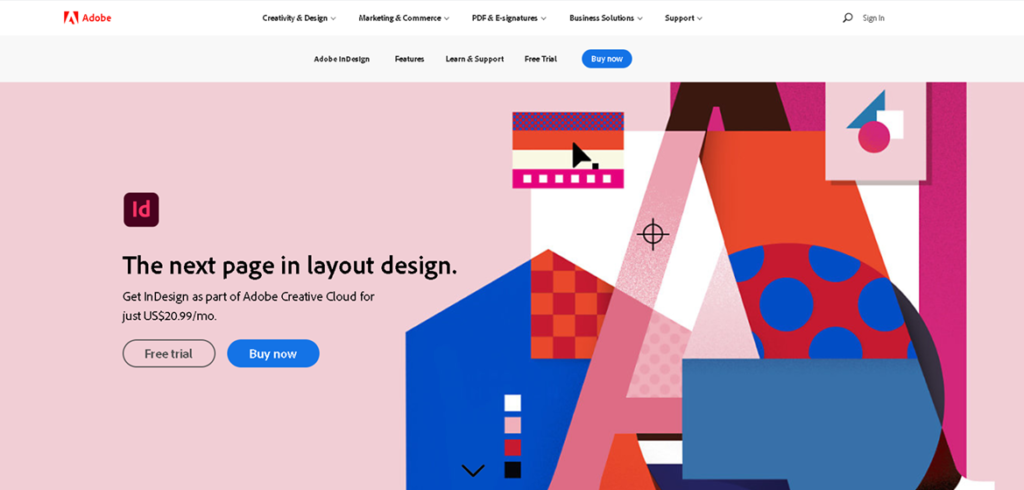
Without a doubt, the Adobe Creative Cloud is one of the most customizable creative software solutions that can be used to create your catalogs.
With Adobe InDesign, you get a page design and layout tool that allows you to create stunning product brochures, posters, flyers, magazines and catalogs.
Before you subscribe to the Creative Cloud, you need to be aware that Adobe InDesign is not suitable for beginners. You need to have creative staff on board to make efficient use of this design software.
Adobe InDesign starts at $20.99/month.
3. Adobe Spark
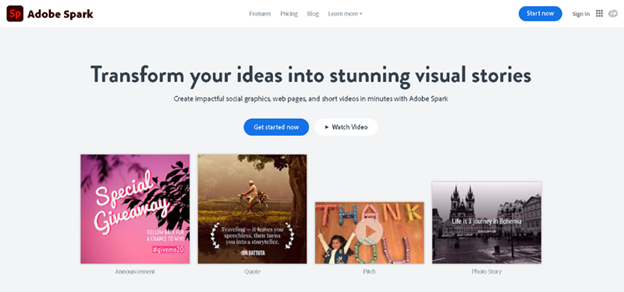
Adobe Spark is also available in the Adobe Creative Cloud and allows people with limited design knowledge to capitalize on its tools and make the most of the catalog management process.
Adobe Spark consists of a wide range of tools that can help you create graphics and videos to include in your digital catalogs in order to boost your e-commerce sales.
Additionally, the creative catalog software has a lot of publication tools to help you reach your audience in seconds.
Adobe Spark starts at $9.99/month and offers various graphic design tools for individuals and small enterprises.
4. Akeneo – for product information management (PIM)

Akeneo is a product information management (PIM) system with which you can collect and manage all your product information and product descriptions in a single place.
The product catalog management software lets you create a stunning catalog that you can easily distribute to all of your sales channels.
Akeneo can be used by marketers, retailers, e-commerce managers and data management teams to enrich product specs, add translations, classify product data and ensure consistency. Moreover, it is an all-encompassing PIM solution for SMEs to large corporations.
Visit Akeneo’s website to install the free open-source community edition or get a custom demo of the enterprise edition.
5. Canva – catalog software for beginners

With Canva you can create stunning visuals for your catalog from a variety of customizable design templates – even without any prior design knowledge.
Drag and drop options enable you to combine different visual elements to create unique images. Even though Canva is not a fully-fledged catalog software, it can help you create professional designs for your catalog pages.
While Canva Basic is free, the Pro plan starts at $12.95/month.
6. Catalog Machine – easy catalog software management
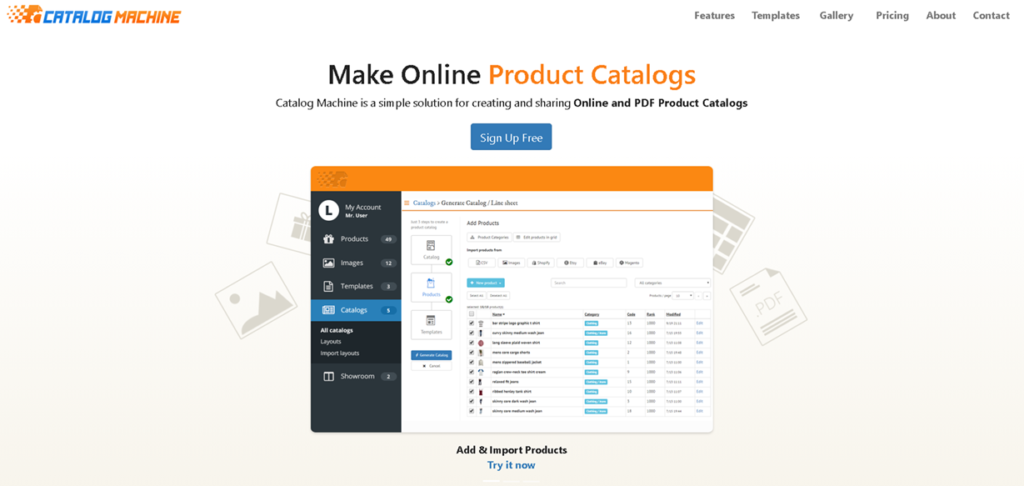
If you need to produce a stunning digital software catalog, Catalog Machine offers all the tools you need. This product catalog management software allows you to create and share product catalogs both online and in PDF form.
With the help of customizable templates for a wide range of products and industries, you do not need any technical or design knowledge to create unique catalogs.
The integrated online database of Catalog Machine helps you store all product information in one place, while the catalog builder enables easy conversion of these product descriptions into a wide range of customizable catalog types.
Catalog Machine Lite starts at $19/month and includes space for 100 products, 5 catalogs and 50 pages.
7. Catalog Maker – affordable digital catalog creator
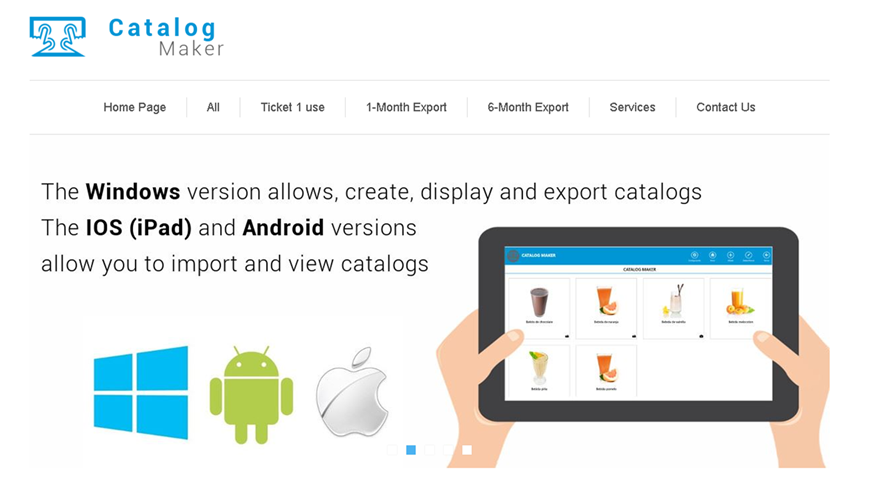
Product Maker is an affordable digital catalog and brochure design software that enables individuals or SMEs to create a wide range of online product presentations.
Product Maker lets you create clear and stylish touch brochures and catalogs. With this software, you can create, import, export and view all of your catalog collections. The catalog software is especially designed for touch devices and works with Windows 8.1, Windows 10, IOS or Android systems.
Single ticket usage is available at only $1.50, while monthly plans start at an affordable $12.
8. CleverCat – hybrid catalog management software
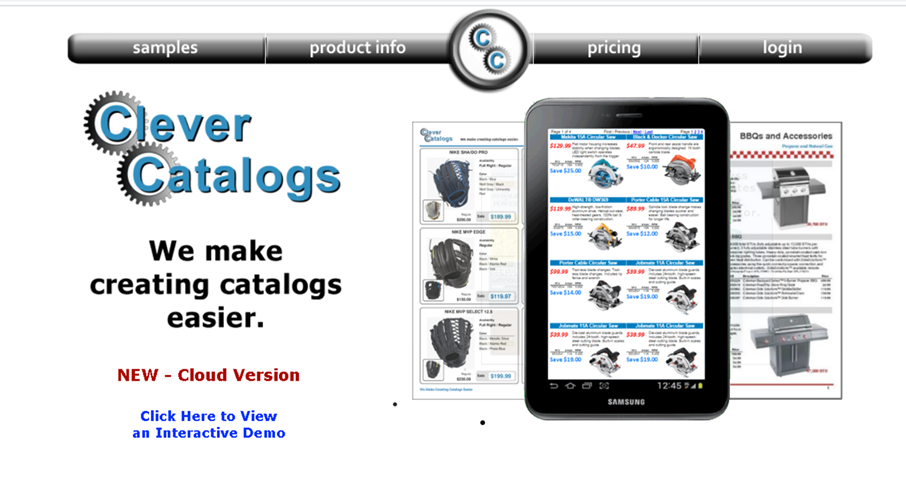
CleverCat is a cloud-based product catalog management software that uses intuitive drag-and-drop tools to help you create printing templates in minutes instead of weeks or even months.
The hybrid application catalog software combines the design flexibility of page design software with the speed and ease of database-driven catalog software.
With CleverCat, you can easily import and synchronize product data using a CSV file and add texts, prices, quantities, dates, photos or barcodes to the template designer.
Furthermore, CleverCat cooperates with Yumpu.com to convert your PDF catalogs into an appealing flipbook format.
CleverCat’s yearly subscription starts at $119.
9. DCatalog – digital catalogs publishing tool
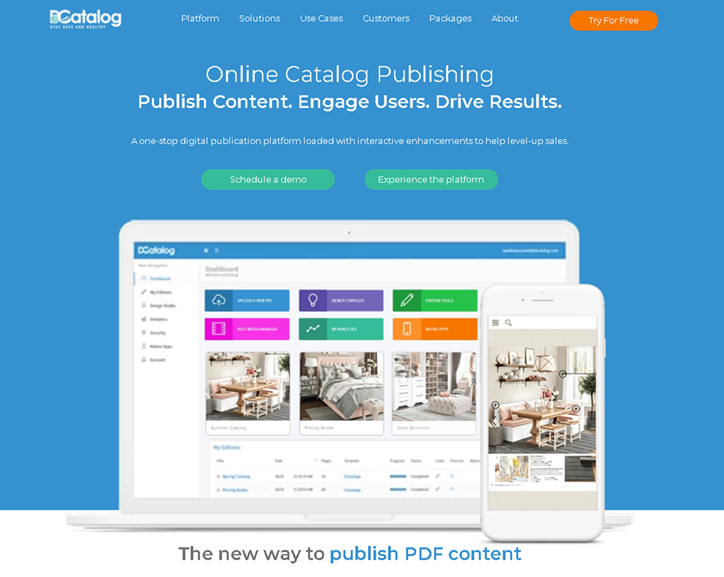
DCatalog focuses on the last step of the catalog management process. This one-stop digital publication platform allows you to easily publish your PDF content across multiple channels, including your e-commerce platforms.
The digital creator mainly caters to publishers and marketing professionals to publish HTML5 digital flipbooks.
DCatalog includes a wide range of analytical tools which let you track the number of visitors, page views, time spent, links clicked on and much more so that you can further improve your catalogs.
Contact sales to request a demo and a quote.
Supercharge your content reviews
Share, review, and approve all your content in one place with Filestage.
10. FlipHTML5 – free flipbook designer
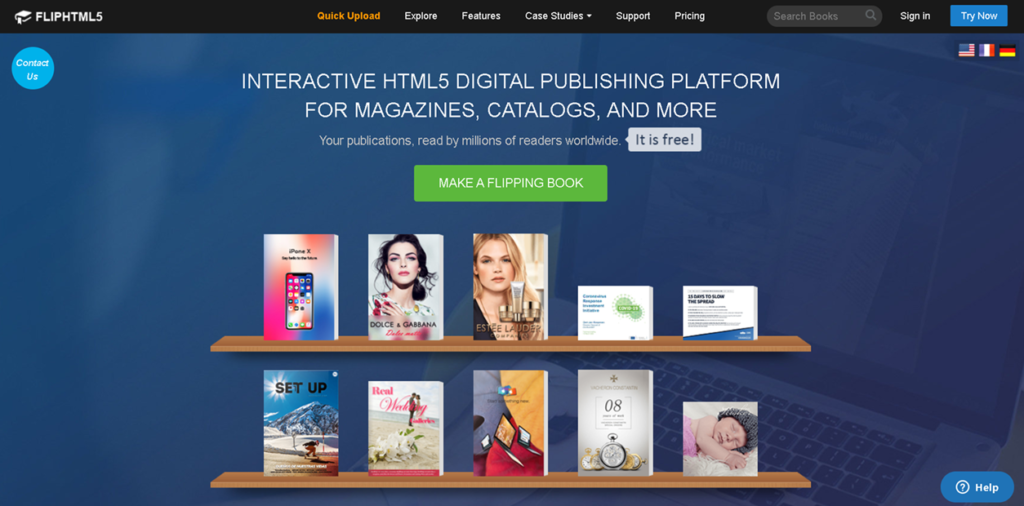
FlipHTML5 is a catalog creator software with a focus on interactive flipbooks. Whether you want to employ links, images or even sounds and videos, FlipHTML5 comes with a wide range of interactive elements that will make your product presentation stand out.
With FlipHTML5, you can turn your PDF or office/openoffice documents and images into visually appealing magazines, catalogs and books. Moreover, you can easily publish your flipbook by using the publishing catalog software.
FlipHTML5 is available for free. With the pro version starting at $12.50/month, you can disable the FlipHTML5 watermark stamp and add more features.
11. FlippingBook – interactive PDF catalog creator
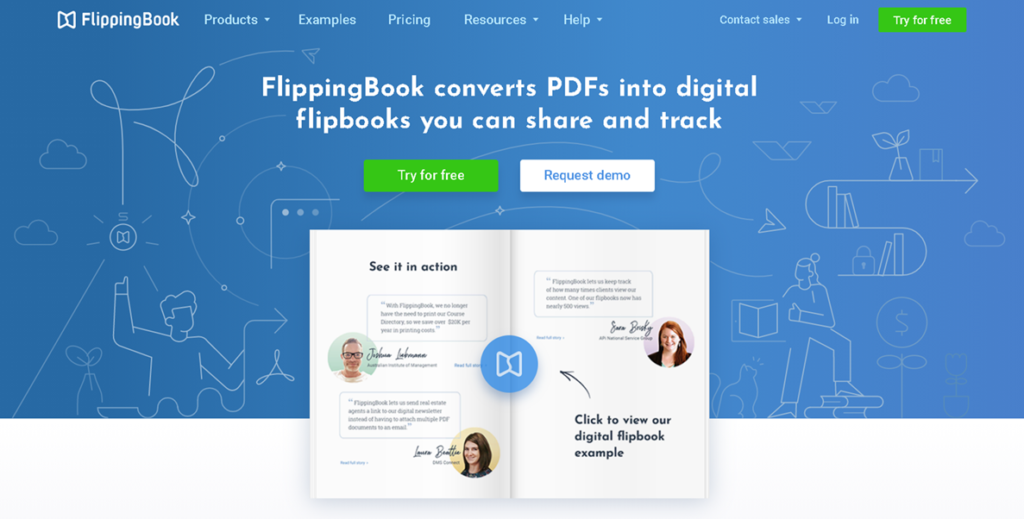
FlippingBook helps you convert your PDFs and publish digital flipbooks. Additionally, you can easily track the assets’ performance and bring your e-commerce platform to the next level.
With FlippingBook, you make the most of your digital catalog by transforming still images into engaging and interactive designs which can even collect sales leads.
No matter if you are a B2B manufacturer or a B2C marketer, FlippingBook is a multi-purpose product catalog management software that will make your product stand out from the crowd.
The FlippingBook starter plan is available at $44/month.
12. Flipsnack – flipbook catalog creator and publishing platform

Flipsnack is a catalog software that offers a wide range of design tools with which you can turn your standard catalog into a unique and interactive flipbook.
Whether you want to create something completely new with drag and drop editing tools or start off from templates – Flipsnack has the solution for you and your design needs.
In addition to a wide range of design functions, Flipsnack also offers advanced features, such as publishing options as well as analytical tools that you can use to make improvements when needed.
While the basic plan is free, the starter plan comes at $14/month and integrates publishing and sharing options.
13. iPaper – shoppable flipbooks
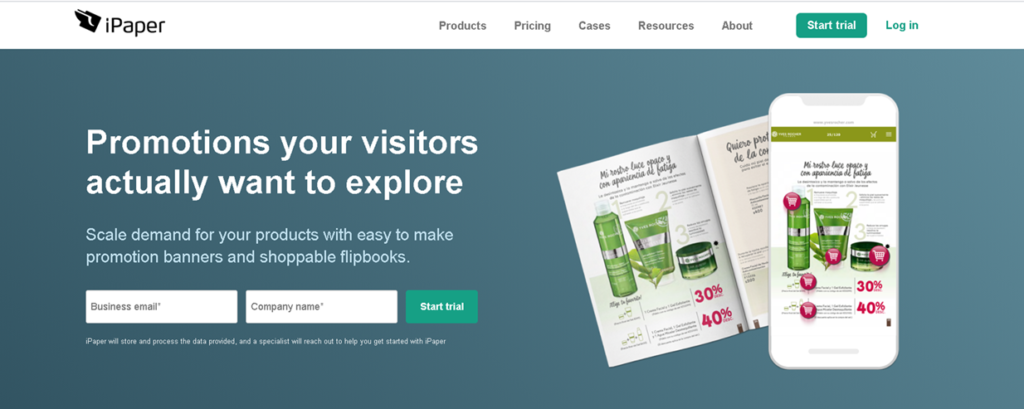
iPaper is an interactive promotion tool that allows you to create promotion banners and shoppable flipbooks.
iPaper offers multiple features with which you can automatically add product links, customize checkout flows and track the performance of all of your promotions.
With iPaper, you can create and publish promotions and shoppable catalogs for a huge variety of markets; its intuitive no coding interface makes it possible. Depending on the subscription that you choose, you can also gain access to a wide variety of catalog automation features.
The shoppable flipbook commerce light edition starts at $300/month.
14. Issuu – convert your PDFs into interactive catalogs and Instagram stories

Issuu brings your product content to a new level. With the Issuu, you can tell your brand’s story by turning PDFs into engaging articles and videos.
Using Issuu, your catalogs can easily be shared on social media and enriched with SEO keywords for organic growth. Thanks to the analytical features of Issuu, you can also get a thorough insight into your reads, impressions, average time spent and many more stats.
Issuu reaches over 50 billion page views in a year on its innovative product content publication platform, making it a perfect tool for marketers, designers and social media managers.
Issuu Basic is available for free while the starter subscription plan is available at $19.
15. Lucidpress – creative brand templates
Lucidpress offers all the tools you need to tell your visual brand story – no matter if you are an individual content creator, an SME or an enterprise.
Customizable interfaces allow you to create unique high-quality designs, while the Lucidpress workflow management tools enable you and your team to collaborate efficiently.
To get started, you can choose between hundreds of templates which cater to a wide variety of industries and products.
The basic Lucidpress package is available for free, while professional teams can start at $10/month.
16. MyCreativeShop – catalog printing services
MyCreativeShop delivers many design templates for multiple purposes, such as flyers, postcards, brochures, door hangers and other marketing assets.
In fact, MyCreativeShop offers 25,000 customizable templates, 3,500 of which are specific to brochures and catalogs. You can also use the editing tool for a multitude of customization options.
MyCreativeShop not only helps you create digital assets but physical assets as well. If needed, you can even request to print catalogs directly from the platform (if your company is based in the United States or Canada).
MyCreativeShop is available at $19.95/month.
17. Pagination – turn your product data into compelling brand stories
Pagination is a very useful platform that allows you to take data from virtually any source and convert it into compelling and attractive brand stories.
You can convert Excel, Access, SQL, Magento, Prestashop and many more types of files into beautiful documents.
In Pagination, automated workflows allow you to integrate your data inside the document – saving time and leading to more consistency and higher quality output.
Whether you want to create high-quality price lists or beautiful catalogs, the Pagination catalog creator offers efficient tools to upgrade your visual storytelling.
Pagination’s professional version is available at $550/year.
18. Publitas – publish catalogs with ease
Publitas can help SMEs and large corporations create dynamic flyers, visuals and catalogs and then publish them on the web. Accordingly, your customers will get an enhanced desktop and mobile shopping experience which will result in being successful on multiple sales channels.
This publishing platform has over 60 million monthly readers and more than 900 million monthly page views. Additionally, Publitas not only serves as a digital platform but also enables you to easily print catalogs and all of your publications.
The Publitas Bronze Plan starts off at $29/month.
19. Scribus – open source publishing platform
Scribus is a free publishing software that comes with a wide range of useful tools, including vector drawing, multiple file type support and rendering of markup languages like LaTeX or Lilypond.
Scribus offers an open source desktop publishing solution that has a steep learning curve, but includes a lot of functions at no costs.
If your design team has the capabilities needed, Scribus offers one single solution to create stunning brochures, magazines and catalogs which are perfectly customizable to your needs.
Scribus is available for free.
20. Webpublication – InDesign capabilities for beginners
Webpublication is an intuitive platform that enables you to make use of Adobe’s InDesign functionalities, even if you have never worked with the complex program before.
The intuitive drag and drop interface results in the creation of stunning interactive catalogs, digital magazines, press kits, reports, advanced PowerPoint presentations and much more.
With Webpublication, you can save valuable time, streamline your creative design process and achieve higher quality results and more consistency at a much cheaper price.
This results in a unique customer experience and will contribute to the bottom line of your organization.
Get in touch with the Webpublication sales team for a demo, pricing and further product information.
Now that we have described our picks of the Top 20 catalog software, the next section will take a look at the best design tools and templates that you can use without spending a single penny.
Free catalog maker and catalog templates
How can I make a catalog for free? As you can see from the examples above, there is a lot of useful product catalog management software on the market that can help you achieve your desired results.
However, some of the solutions come at a price which individuals or SMEs cannot afford. Therefore, in this section, we focus on the most commonly used free catalog management software.
1. Canva
Canva offers a free plan with a lot of perks, such as 250,000+ free templates, more than 100 design types as well as multiple design collaboration tools. Take a look at the website to check out the multitude of templates that Canva has to offer. From posters, to logos and infographics – you will certainly find the right customizable template to make the most out of your brand story.
2. LucidPress
The basic version of the Lucidpress catalog creator is available for free and offers many attractive features, such as access to stock photos and icons. The free version is great for beginners but is restricted to three documents with a limit of only three pages each. However, you can gain access to over 800 free templates. Lucidpress basic is especially useful for individuals and small companies that only need a small catalog to present their portfolio.
3. FlipHTML5
FlipHTML5 delivers amazing flipbooks to tell a compelling and interactive brand story. The basic version offers a lot of features, such as five publications to be uploaded a day and 500 pages per book, which is enough for most companies. Note that the free version does leave a watermark on your flipbooks; this is only deleted with the paid subscription plans.
4. Freepik
Freepik makes the lives of your design team easier by offering a wide range of free vectors, stock photos and PSDs that can be used for the next design project of your organization. Through the free version, you can gain access to thousands of resources, while the paid version offers a wider range of features and premium resources.
5. Flipsnack
Flipsnack has a free basic plan that allows you to create up to three different catalogs or other marketing assets with a limit of 30 pages or 100MB. You can take advantage of a wide range of templates catering to products, fashion, books and business purposes. If you want to design your own templates from scratch, you need to sign up for the starter version of Flipsnack.
6. Template.Net
Template.Net provides a huge variety of free templates for many different purposes and industries, including advertising, automotive, education, health, engineering and fashion, just to name a few. No matter if you need templates for Adobe PhotoShop, Illustrator, InDesign, Apple Pages, Microsoft Word, or other file formats, Template.Net is worth a try, even if you are looking for very specific design templates.
7. TemplateLab
If you do not find the right template at Template.Net, TemplateLab is another very popular free template source which offers more specialized design templates to small and medium businesses. Template.Net mainly focuses on business and legal templates, but also includes further categories such as personal, real estate, education and art & media templates. You can be sure you will find the right template for your company if your needs fit into one of these categories.
Now that you have a better understanding of the most commonly used product catalog management software that you can use to achieve your goals, we will take a deeper look at the actual catalog creation workflow.
Final thought
As you can see, product content management is not an easy task. The creation of physical and digital catalogs can be very time-consuming – especially if you do not have the right software at hand. We hope we have given you a good overview of all of the available software solutions, so that you can streamline your catalog management workflow while increasing your ROI.






